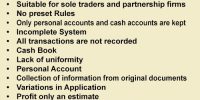Depreciation is the process of allocating the cost of an asset over its life rather than all at once with regard to tax deductions and is used by both large and small businesses. The Internal Revenue Code describes the depreciation deduction as a reasonable allowance for the exhaustion, wear, tear and obsolescence of business assets. There are several methods of depreciation but only two that are widely recognized by the IRS.
Straight-Line
The straight-line method is most commonly used method for calculating depreciation because it is the simplest. It can be used for any depreciate property except for those that are required to use accelerated depreciation methods by the IRS. Under the straight-line depreciation method, the basis of the asset deducted evenly over the asset’s useful life. Each year, the same amount of depreciation is claimed on a business’s tax return. Under Generally Accepted Accounting Principles (GAAP), the straight-line method is used for internal books. In general, the formula for straight-line depreciation equals the asset’s depreciate basis–the original costs to purchase it–divided by its estimated longevity.
Declining Balance
As less common form of deprecation is declining-balance depreciation. This method offers a higher rate of depreciation during the earlier years of an asset’s life and is only useful for assets with a useful life longer than three years. Using the declining balance does not completely depreciate the asset, however, so the IRS lets you switch to the straight-line depreciation method once during the asset’s life.
Accelerated
The Accelerated Cost Recovery System (ACRS) is a method for recovering the cost of personal and real property that has a shorter useful life such, as a computer or automobile. The Internal Revenue Service developed it under the Economic Recovery Tax Act of 1981, and modified it in 1986 (MACRS). The ACRS and MACRS rules were developed to encourage businesses to engage in capital investment more frequently. Different types of property accelerate at different rates according to IRS rules.














